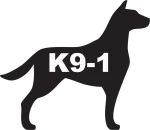After your dog understands how to make the correction for sit go away (escape conditioning) we can teach the conditioned punisher for the command.
Conditioned punishers are created by pairing things we do or say (or any stimulus) that is considered neutral to the dog with an UNconditioned punisher (an actual correction). Eventually the dog reacts the same way to the neutral stimulus as if he has been corrected with a real correction. This is a great way to remain on a continuous punishment schedule with your dog (which produces the best reliability) without needing to always use real corrections.
For applying this to the sit command we will use the word "no" spoken calmy as the conditioned punisher. Technically you can use any word as long as you are consistent. The word "no" is neutral to the dog as long as it is spoken calmy. To get the best results and presentation, do not say the word sternly or with intimating tones. If we teach this correctly the dog will fix themselves from honest mistakes with a simple "no" spoken from you. The dog will only need to be corrected with an actual correction when willfully disobeying your commands or having impulse control problems.
This is how you can humanely teach the "no" conditioned punisher for the sit command:
- Begin the exercise exactly as how you did when teaching the escape conditioning for sit. You will still give a treat reward when the dog first obeys the command and after the "free", but NOT for breaking position. If the dog breaks the command you will still apply the proper correction while calmly saying "sit" until the dog starts to move back into position.
- Now, you can start to add distance by sliding away slowly on the leash while the dog is sitting. Be sure to keep both hands on the leash with your free hand (the one without the handle on the thumb) palm up and ready to slide on the leash toward and over the dog.
- When the dog starts to break the sit command calmly say "no".
- AFTER you say "no", start to move into position to administer the proper correction the dog learned through escape conditioning.
- If the dog does not respond to the word "no" continue with the proper correction as you simultaneously repeat the word "sit". If the dog makes an effort to go back into the sit position before you are able to administer the correction allow the dog to go back into position without a physical correction.
- PRAISE the dog for going back into the sit position whether you had to physically correct the dog or if the dog responded correctly to the word "no".
- Have the dog stay in the command for variable duration of time that you feel reasonable for your dog. You can slide back and forth on the leash and walk circles around the dog. Be sure to praise the dog intermittently for longer duration and to variably mix in affection or food reward. Repeat steps 3-6 as necessary if the dog breaks command.
- End the command by saying the dog's name and then giving a different command or releasing the dog with a "free" from command. Remember that the dog should only hear their name one time at the beginning of a new command and not again until told to do something other than that command. Do NOT use the dog's name when praising or before you correct a dog.
When your dog confidently responds to the word "no" and you feel comfortable and technical with this exercise you can move to the next step, avoidance conditioning.
Here is a video that shows technique on a halter style collar:
Here is an older video that shows technique on a prong style. It is mostly accurate, except say the word "no" only one time. Do not string the "no's" like in the video "no,no,no,no.."

